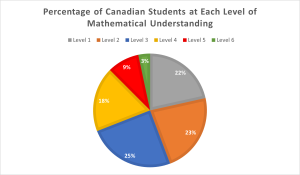Canada’s math skills have been put to the test once again, and the results are sparking controversy. The Organisation for Economic Co-operation and Development (OECD) periodically issues tests to 15-year-olds (grade 10) living within OECD countries, of which Canada is one. These tests, developed by the Programme for International Student Assessment (PISA), measure students’ abilities in math, reading, and science. The most recent PISA test was issued in 2022, and the results are now available for public viewing. They suggest that Canada’s math test scores are dropping.
 How Is the PISA Test Graded?
How Is the PISA Test Graded?
PISA questions are assigned a difficulty rating from level 1 to level 6, with level 1 being the easiest and level 6 being the hardest. Students demonstrate their understanding by answering the questions to the best of their ability, and how they answer the questions determines their overall level of understanding. Each question awards students a certain number of points based on its difficulty and the way it was answered.
Based on their results, students are then assigned a proficiency grade from level 1 to level 6. Level 2 is described as “the baseline level of proficiency students need to participate fully in society.” This means that students at level 1 will struggle to participate meaningfully in society and are “less likely to complete higher education and [attain] better-paying and prestigious jobs in the future.”
To achieve level 2, students need a score of 420 or more. Level 3 is defined as 482 points or more, level 4 is 545 points or more, level 5 is 607 points or more, and level 6 is 669 points or more. Worldwide, 68.9% of students demonstrated a level 2 understanding or above. 2% of students worldwide demonstrated a level 6 understanding.
What Does the PISA Test Look Like?
According to the OECD, “the new PISA 2022 mathematics framework considers that large-scale social changes . . . have reshaped what it means to be mathematically competent and . . . a thoughtful, engaged, and reflective citizen in the 21st century.” They also say that “being mathematically proficient is less about the reproduction of routine procedures and more about the use of mathematical reasoning; that is, thinking mathematically in ways that allow students to solve increasingly complex real-life problems in a variety of 21st-century contexts.”
So, the PISA test aims to test critical-thinking and problem-solving skills in real-world contexts. This means students need to be able to recognize mathematical processes in situations where math isn’t necessarily the first thing one would normally consider. Students also must be able to make informed decisions about how to handle problems based on what they know about mathematical principles.
If you’re interested, you can take the test yourself to see what it’s like! The test questions are titled Car Purchase, DVD Sales, Moving Truck, Solar System, Triangular Pattern, Points, Spinners, and Forested Areas. Just click on the language in which you’d like to view the test questions, and away you go!
 How Did Canada Perform on the 2022 PISA Test?
How Did Canada Perform on the 2022 PISA Test?
According to the 2022 PISA results publication, Canada’s mean math score was 497 while BC’s mean score was 496, both of which constitute a level 3 understanding. Within Canada, Quebec’s mean score was the highest (514) which is at the higher end of a level 3 understanding. The highest mean of all OECD countries was Singapore’s 575 (level 4 understanding). The lowest mean of all OECD countries was Cambodia’s 336 (level 1 understanding).
12% of Canadian students were high achievers (level 5 or higher), which is more than the global average of 8.7%. However, 22% of Canadian students were at level 1, suggesting that one-fifth of young adults in Canada will be unable to participate fully in society after graduation. For a local comparison, 34% of students in the United States were at level 1.
In Canada, the most common designation was level 3, with 25% of students fitting into that level. At level 3, students “begin using computational-thinking skills to develop their solution strategy” and “are able to solve tasks that require performing several different but routine calculations that are not all clearly defined in the problem statement.” They also “typically show some ability to handle percentages, fractions, and decimal numbers.”
Though they weren’t the primary focus of the 2022 PISA test, a few reading and science questions were also included. In terms of reading ability, Canada’s mean score was 507. Interestingly, Alberta’s mean reading score was 525, which was the second-highest mean score in the world (Singapore was at the top with a mean score of 543). In science, Canada scored a mean of 515, while BC scored a mean of 519. Alberta again was the highest in Canada and fifth in the world with a mean of 534.
So… Are We Getting Smarter?
The last time PISA issued a test like this was in 2018, and Canada’s mean math score that year was 512. Canada’s mean math score for 2022 was 497, meaning students on average scored 15 points lower. So, Canada’s math test scores are dropping. However, this drop isn’t unique. Almost every other OECD country saw their math scores drop compared to the last time they took the PISA test in 2018.
Other highly ranked countries such as Estonia, Switzerland, Poland, Denmark, Belgium, and Finland all saw significant decreases in their mean math scores, some by as much as 20 points. Norway, Germany, France, and Italy, who had previously ranked in level 3 like Canada, saw their mean math scores decrease by 33 points, 25 points, 21 points, and 16 points respectively, dropping them all into a level 2 understanding on average.
Much of this worldwide decline in math scores can be attributed to the COVID-19 pandemic and the educational disruptions it caused. But it must be acknowledged that Canada had already been trending downward in terms of mean math scores. In 2003, Canada’s mean math score was 532—a significant 35 points higher than 2022’s.
Is Canada in Trouble?
An article from the Globe and Mail suggests that, in Canada, “math has been a worry for politicians, educators and parents” and that the 2022 PISA test results reinforce “the continuing domestic concern about how the subject is taught in schools.”
We have previously discussed the problem with standardized tests and why their results shouldn’t be taken too seriously, but the PISA test promises to be different. The OECD has designed the PISA test such that all of its questions are as likely to come up in real life as they are in a classroom—there aren’t any trick questions or contrived scenarios that are impossible to encounter in the real world. So, a student’s results are always going to be a pretty close approximation of their ability to apply mathematical reasoning in useful ways.
It certainly seems concerning that just over 50% of Canada’s 15-year-olds came in at level 3 or above, meaning that only about half of those who took the test “typically show some ability to handle percentages, fractions, and decimal numbers.” According to the BC math curricula, students should start working with fractions and decimals as early as grade 4. Considering that students are usually in grade 10 when they take the PISA test, they should already be able to confidently work with percentages, fractions, and decimals.
How Do We “Fix” the Problem?
According to the Globe and Mail, “experts have advocated for a back-to-basics approach where students grasp the fundamentals rather than an inquiry-model where they learn through problem-solving, pattern discovery and open-ended exploration.” However, this prescription runs counter to what the OECD suggests students need to succeed in the modern mathematical world.
“To develop students’ ability to reason mathematically,” the OECD says, “schools and education systems need to go beyond teaching and evaluating routine mathematical procedures—students need to be ready to address unfamiliar real-world problems and apply the mathematical tools they have in new ways.”
Of course, some mathematical concepts do require a certain amount of rote learning to perfect, such as times tables. But the PISA test isn’t quizzing kids on their times tables—it’s asking them to apply the fundamentals of many branches of math in new and nuanced contexts they might not have considered before. So, the “problem” is manifold and needs to be treated with a little more care than the reflexive “back in my day…”
 Inquiry-Based Learning
Inquiry-Based Learning
At Tutoring…With A Twist*, we are major proponents of inquiry-based learning. According to Lee et al, “inquiry in the classroom places the responsibility for learning on the students and encourages them to arrive at an understanding of concepts by themselves.” It helps students approach subjects with curiosity and develop deeper levels of comprehension while constructing a sense of independence. In a one-on-one tutoring scenario, inquiry-based learning allows students to reach academic heights otherwise unachievable through traditional approaches.
In a school setting, inquiry-based learning can have mixed results. Of the upwards of 30 kids in a classroom, many of them will need more direction than what is offered through inquiry-based approaches. This, of course, is an inherent flaw in the school system—every student is different, but teachers often have to resort to attempts at a one-size-fits-all solution. Some students thrive when given free rein to inquire and explore, while others crave more rigorous explanations so they can better orient themselves amidst unfamiliar ideas.
The best approach is a blend of both. When introduced to something new, especially in math, students need a basic framework of understanding before they run off and try to solve problems on their own. And in reality, this is how math is most often taught in school. Teachers direct students to take notes, providing them with some basic definitions and examples demonstrating how to perform the necessary calculations in various situations. Students are then assigned a worksheet or textbook questions so they can try applying their knowledge in new ways, learning through inquiry when they encounter more difficult problems.
Canada’s Math Test Scores Are Dropping… Whom Do We Blame?
Fortunately, along with grading students’ PISA tests, the OECD collects a bunch of other information that can help contextualize the results and diagnose issues.
Based on their findings, the OECD reported that, in Canada, 90% of all test score variation was due to differences within schools themselves, as opposed to differences between schools. “This means,” they say, “that school characteristics do not play a dominant role in explaining student performance; instead, it is the characteristics of students themselves (i.e. their background, attitudes and behaviour, etc.), and the characteristics of different classrooms . . . that account for most of the overall variation in student performance.”
So, a student’s success is more reliably tied to their own background and engagement in their own school, and not which school they happen to attend. In other words, no matter which school a student happens to attend, they have approximately the same chance of achieving high levels of success as someone from a similar background attending a different school.
These findings challenge the idea that some schools are better than others; based on the PISA scores, it simply isn’t true. More interestingly, we now know that schools which pride themselves on using a particular model of education—inquiry-based learning, for example—are likely to score the same on average as schools using a different model or a blend of models. So, inquiry-based learning isn’t the reason why Canada’s math test scores are dropping either.
Socio-Economic Status
We must be mindful that students in disadvantaged socio-economic positions face many hurdles other students do not. If a student goes to school without having breakfast and needs to dedicate after-school hours to working instead of studying, they can’t be expected to score highly on standardized tests.
In almost every country in the OECD, Canada included, socio-economic status can be used as a predictor for educational outcomes. Worldwide, a country’s students in the top 25% of socio-economic status scored an average of 93 points higher on the 2022 PISA test than the students in the bottom 25% of socio-economic status for that same country.
For some countries, the stratification was more pronounced. However, in some countries, like Canada, the gap in mathematical ability between the students with the highest and the lowest socio-economic statuses was narrower. Students with the highest socio-economic status could expect to score about 80 points more than those with the lowest socio-economic status.
For this reason, Canada is considered more socio-economically fair than many other countries. In other words, Canadian schools, in general, strive to provide all students with the opportunity to obtain a high-quality education regardless of background. Also, since socio-economic differences have always existed, we can’t blame recently falling test scores on them.
 An Administrative Problem
An Administrative Problem
We’ve learned that 90% of differences in student performance in Canada can be linked to differences within individual schools. Having already controlled for socio-economic status, we must look at the other factors that could be different within any given school.
By the time a student finds themselves at the age of 15 and sitting in a grade 10 classroom, there is no telling what their math journey has looked like up to that point. In BC, there are fixed math curricula for every single grade, but not every student is responsible for learning the content therein.
It seems increasingly common that students are able to float through each grade from kindergarten to grade 9 without retaining much of anything. Personal accountability is important here, of course—kids should understand from a young age that it’s important to try their best and that learning, especially learning how to learn, is in their best interest. But it’s easy for students to think otherwise when they aren’t expected to do any of that.
Chris Bordeleau, one of our twisted tutors, has worked with many math students over the years. When it comes to his students between grade 8 and grade 10 specifically, he never knows what to expect. “Some grade 8 students are being asked to graph and interpret linear relations,” he says, “and they’re excelling at it. At the same time, some grade 10 students don’t know how to find 5% of 100. And I don’t blame them.”
Let’s Blame the Teachers!
Even though the math curricula are prescribed, many kids in grades kindergarten through 9 aren’t learning everything the government says they will. Many teachers try to provide their students with only a basic understanding of each concept before moving on to the next topic, while a rare few truly challenge their students. Sometimes topics are even skipped altogether.
“You can tell when a student is being held to a high standard or not,” Chris says, “by looking at which homework questions they’re being assigned. Most kids are only required to complete a handful of questions under the ‘Practice’ and ‘Apply’ headings. All the juicy questions, the ones marked ‘Extend’ and ‘Create Connections’—the sorts of questions students are likely to see on the PISA test—those ones are almost never assigned.”
And if the juicy questions, as Chris says, are almost never assigned, how can kids be expected to answer them correctly on a standardized test? What’s more, students aren’t even responsible for knowing how to do the questions they are assigned. Some teachers don’t require students to hand in math homework, and those who do usually only award a completion mark instead of marking each question.
“The thinking here,” Chris says, “is that those who do the homework will perform better on the tests and quizzes, thus giving students incentive to do the homework even if it doesn’t directly affect their grade. The problem is, when a teacher says the homework isn’t for marks, kids don’t think, ‘Oh, I should do the homework anyway so I can pass the test.’ They think, ‘I don’t have to do homework this year? Sweet!’”
As part of the questionnaire associated with the 2022 PISA test, the OECD asked students if they would have tried harder on the test if it had been for marks. A staggering 71% of students said yes. So, when work of any kind isn’t marked, students are far less likely to do it, and if they do decide to do it, they are less likely to put their full effort into it. Knowing this, it seems as though teachers should always mark math homework.
But students are usually provided with an answer key so they can check if they understand the material as they work through it, allowing them to get instant feedback on what they know and what they don’t know. To have a teacher spend hours marking math homework is thus redundant. Instead, we need to understand why kids first develop the thought that homework isn’t important.
 Actually, Let’s NOT Blame the Teachers!
Actually, Let’s NOT Blame the Teachers!
Until grade 10, students can’t be forcefully held back a grade if they haven’t met the learning outcomes for that grade. A student in grade 9 who has failed every math quiz and test that year still graduates to grade 10.
It’s no surprise, then, that the pace and workload of a grade 10 math class combine to blare a major wakeup call for most students. Perhaps for the first time, students are required to work on prescribed content and complete the entire curriculum from start to finish. And definitely for the first time, failure is possible. Those who haven’t yet developed a sense of personal accountability are forced to rapidly do so. And if they don’t…
Lack of personal accountability seems to be something of a systemic issue in schools. We’ve learned that, if something doesn’t seem absolutely necessary, students won’t do it, or at least they won’t try as hard when doing it. “If I knew that I didn’t technically have to eat or sleep,” Chris says, “I wouldn’t do those things at all. Imagine how much more time I would have in a day! Kids think the same way. If a student knows they can get away without trying hard in school, they have to rely on a strong sense of intrinsic motivation to do so anyway.”
The trouble is, even high achievers can develop a lack of motivation. The founder of Tutoring…With A Twist*, Amber Scotchburn, discusses this phenomenon at length as it pertained to her son Marley. She describes how, when she was a teacher, she always came to expect at least “a two-year aptitude span on either side of the grade [she] was teaching.” For example, a grade 3 classroom may be filled with some students at a grade 1 level of understanding, others who could probably tackle the grade 5 content, and a bunch of kids somewhere in between. For the high achievers, like Amber’s son Marley, their reward for breezing through their work is long periods of sitting at their desks with nothing to do. The punishment hardly fits the crime!
Again, it’s difficult to blame the teachers for this outcome. The school system as a whole doesn’t equip teachers with the resources to accommodate everyone in their classroom. Each student is forced to move at the pace of the class and not according to their abilities. For some, that’s too fast. For others, that’s too slow. In both cases, motivation takes a hit.
What’s the Verdict?
The true solution, it seems, is to set up an education system in which students are able to explore the curricular content as deeply as they need to before moving on to the next topic. A system which groups students according to their subject-based ability so they can all move along at an appropriate pace and thrive together. A system which holds students accountable for their actions, rewards them accordingly, and encourages them to be the best they can be. A system, in short, just like the one used by the country consistently achieving the best PISA test results in the world: Singapore.
But while you’re waiting on a full education reform, we’re here to help! At Tutoring…With A Twist*, we acknowledge that every student’s learning journey looks different—as it should! We’ll meet your child at their current level of understanding and instill them with the confidence to take their learning to new heights. No matter your child’s goals—getting an A in math, bringing up the national average PISA score, or just feeling comfortable saying “I don’t hate school”—we’re always excited to lend a hand!
If you’d like to learn more about the twist, don’t hesitate to contact us. We’d love to hear from you!
Please feel free to share your thoughts about the OECD, the PISA test, and why you think Canadian test scores are dropping—leave a comment down below!
If you’d like more great content, follow us on Facebook and check out our YouTube channel!
*Services provided by With a Twist Education Ltd.

